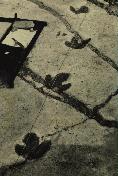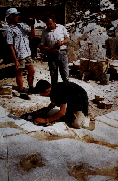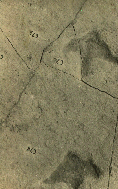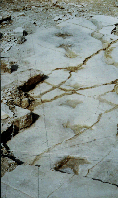
Sandstone
Purbeck
Polished
Rockery
Flint
Flooring
Sawn
Dinosaur
Durability
Riven
Paving
Granite
Building
Boulders
Walling
History
Technical
Setts
Products
Map
![]()
![]()
The track way found at the quarry of J. Suttle Swanage Quarries in 1961 and later transported to the British Natural History Museum at South Kensington, London.
The Isle of Purbeck is an area of Southern England, U.K. which is famous for its Limestone which has been quarried for centuries to provide building stone both for local use and for use around the U.K. particularly in London.
The track way was discovered during the routine quarrying operation when an area or "patch" of stone is uncovered ready to be extracted by hand or by machine for later hand working. The beds of stone uncovered
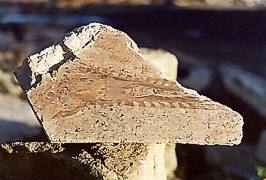 |
which produced the footprints are locally known as the "Roach" beds. This is a bed of middle Purbeck Limestone formed during the cretaceous period some 130 million years ago. The Roach bed is approximately 700 mm high and splits readily using a hammer and punch (a pointed chisel) through the bedding planes to provide various thickness' of slabs from thin paving and cladding (around 20 - 30 mm thick) to stone suitable for walling (around 100 mm thick).
The track way was unusual in that it was the longest track way that had been found in the U.K. It was identified as being the print of Iguanadon and at first it was thought to be the track way of one animal but closer research revealed that it was in fact two sets of dinosaur prints. Iguanadon and Megolasaurus
The individual prints were plotted and given an identifying number and transported to South Kensington.
Part of the track way can now be found in the permanent Wildlife Garden at the Natural History Museum.
J. Suttle Swanage Quarries were pleased to have been associated with the provision of stone for the Wildlife Garden.
for further information contact dino@stone.uk.com Visit the Company web page at www.stone.uk.com
|
J. Suttle Swanage
Quarries, California Quarry,
Swanage, Dorset, BH19 2QS
+00 44 (0) 1929 423576 (facsimile 427656)


